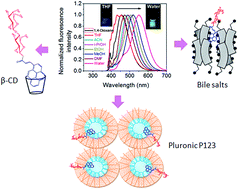Introduction of an α,β-unsaturated carbonyl conjugated pyrene–lactose hybrid as a fluorescent molecular probe for micro-scale anisotropic media†
Abstract
A new fluorescent lactose molecule (pyd-lact) (E)-1-(galactose-β-(1→4)-β-D-glucopyranosyl)-4-(1-pyrene)-but-3-en-2-one, has been synthesized by attaching 1-pyrene-but-3-ene-2-one to lactose. Extended π-conjugation removes the emission forbiddenness of pyrene, which results in the broad spectrum. Detailed photo-physical studies in homogeneous media show the sensitivity of ICT (intra molecular charge transfer) emission towards medium polarity. Unlike pyrene, pyd-lact is more soluble in water at a probe concentration of 10 μM, because of the attached disaccharide. Thus, the usage of pyd-lact as an aqueous probe is found to be advantageous over pyrene. Using the polarity sensitivity of fluorescence parameters (intensity, shift of emission maximum, anisotropy, lifetime), the micro-heterogeneity of anisotropic media such as β-CD, bile salts, and Pluronic P123 have been monitored. In contrast to pyrene-3-carboxaldehyde, which is often used as a hydrophobic fluorescent molecular probe, pyd-lact reports from the interfacial regions of micro-heterogeneous media.


 Please wait while we load your content...
Please wait while we load your content...